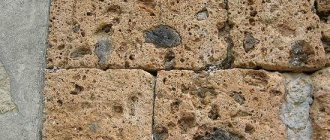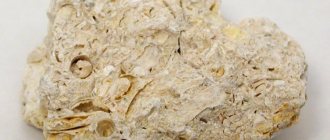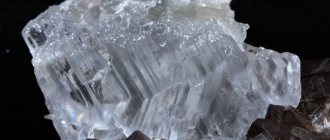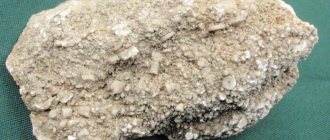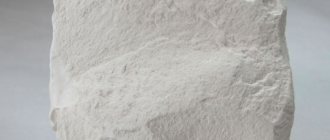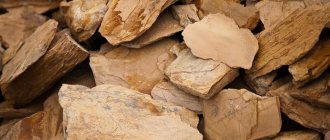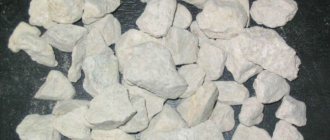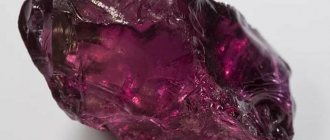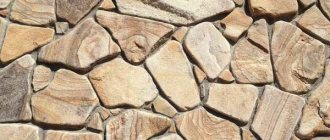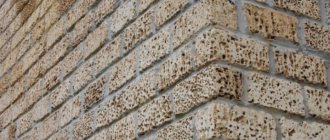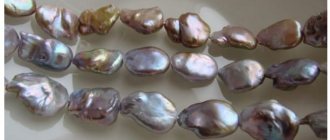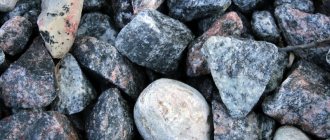Dolomite is one of the main rock-forming carbonate minerals along with calcite. In the minerals of this group, the process of isomorphism is widely manifested, leading to the mutual substitution of chemical elements in their composition that are similar in chemical properties. Given the prevalence of calcite and dolomite, these phenomena often occur between limestones and dolomites. In this regard, transitional varieties of these rocks have been identified, one of which is dolomitic limestone.
Properties [edit | edit code ]
The composition of the mineral is close to theoretical. Trigonal syngony. The crystals are rhombohedral. L6 3 C. Usually massive, coarse- to fine-grained and porcelain-like aggregates. Color - colorless or white, yellowish, brownish (due to the admixture of iron hydroxides and clay particles). The luster is glassy to matte and pearlescent. The cleavage is perfect. Hardness 3.5-4.0. Fragile. The fracture is stepwise to conchoidal (in porcelain-like aggregates). The line is white. It reacts weakly with HCl (however, it boils violently in hot HCl). It boils under the influence of a 1% solution of hydrochloric acid in powder (in a scratch).
Limestones and dolomites
Continuing to talk about sedimentary rocks, which we wrote about in the previous article, it is worth dwelling in more detail on the description of the characteristics of the rock depending on the structure, grain size and the connections that arise between them. As we mentioned earlier, depending on these differences, the rock may have certain physical and mechanical properties, which we will describe for materials such as limestone and dolomite.
Silicified and dolomitized limestones are characterized by increased strength and hardness. With an increase in the number of micro- and fine-crystalline grains of calcite and a decrease in the content of organic material, the strength of sedimentary rocks of this type increases. The compressive strength depends, in particular, on the porosity: the higher it is, the lower the strength. With the same porosity, they have unequal strength.
Limestones, especially those containing an admixture of clay particles, soften in water. The elastic modulus changes according to the degree of filling of the pores with water: at 70-80% filling it does not change, at 90% it decreases by 10-30%, and at complete water saturation by 25-80% of the original value. The physical and mechanical properties of carbonate rocks depend on historical and geological factors. These sedimentary rocks are permeable only through cracks. With increasing strength, their fracturing increases. The ability to weather depends on the composition, texture and structure. Marly species weather easily. Dense, fine-grained limestones are more stable than porous ones.
Dolomites usually contain gypsum and anhydrite as impurities, less often and in smaller quantities, magnesite, fluorite, opal, etc. In appearance and occurrence conditions, they are similar to limestones. The color of these sedimentary rocks varies (from light yellow, red and black). The structure varies from dense micro-grained to very porous.
Dolomites are rocks of marine origin, formed in hot climates. The salt concentration in the pool should be intermediate between the concentrations at which limescale and calcium sulfate are deposited. There are primary and secondary sedimentary rocks of this type. The former were deposited in marine brackish lagoons and have a uniform granular structure, the latter arose as a result of modification of calcareous silt, as well as limestones under the influence of magnesium solutions. The second of these occur in the form of layers and lenses, characterized by unclear layering and an uneven granular structure. Some are of organogenic origin.
These sedimentary rocks are characterized by increased strength and hardness. At the same time, they contain an admixture of gypsum, are fissured, and have significant porosity, including porous-cavernous porosity, which is unfavorable from an engineering-geological point of view. For dolomites and limestones, it is necessary to evaluate the structure of the pore space. Low porosity, high water permeability, and low bound water content indicate large pores and cracks. On the contrary, high porosity, but low water permeability and a significant amount of bound water are a sign of very small pores.
Diagnostic signs [edit | edit code]
It is not easy to distinguish dolomite from other carbonates. Moreover, it is often associated with calcite, which has similar diagnostic features, primarily the rhombohedral appearance of the crystals. In the field, hydrochloric acid is commonly used to determine these minerals. A piece of mineral the size of a match head is placed on the glass and HCl is dripped onto it. Calcite violently “boils” in cold acid with the release of carbon dioxide, while dolomite reacts very slowly, reluctantly, and dissolves only when heated.
Limestone as a mineral, properties of limestone:
Limestone is a sedimentary, clastic rock of organic, less often chemogenic origin, consisting mainly of calcium carbonate (CaCO3) in the form of calcite crystals of various sizes. The composition of limestone includes various impurities; in some cases, individual shells are distinguishable and recognizable in the limestone.
Limestone is a mineral formed in the seas and oceans, as well as in freshwater bodies. Limestone deposits were formed in different geological eras. The formation of most limestones occurred and is currently occurring (for example, coral reefs) due to the extraction of calcium carbonate by living organisms from sea water to build shells and skeletons. The remains of dead living organisms settle and accumulate on the seabed. Calcium carbonate, precipitated from the water saturated with it, is added to the settled limestone debris on the seabed.
Rice. 1. Limestone
Limestone is a natural stone, known and used in construction since ancient times. As a rock, limestone is used to a greater extent than other types of stone, with the exception of marble and granite.
Limestone has a different structure: from very small (on the order of several micrometers) grains to large (the size of a pea).
The color of limestone has a wide range of colors: white, gray, yellow, pink, peach, gray-lilac, brown, brown, blue, as well as all their possible combinations and shades. The color of limestone is determined by the presence or absence of impurities.
Limestone is a soft and porous material that can be easily processed.
Limestone deposits are found on almost all continents, with the exception of Australia. The thickness of the layers varies from several centimeters to hundreds of meters.
Rice. 2. Limestone
Pure limestone in its chemical composition consists of calcite. At the same time, 56% is formed by CaO and 44% by CO2.
contained in limestone can slowly dissolve in water and also decompose into carbon dioxide and corresponding bases. The first process is the most important factor in the formation of karst, the second, occurring at great depths under the influence of the deep heat of the Earth, provides a source of gas for mineral waters.
How to determine soil acidity level
Before using lime or dolomite flour, it is imperative to accurately determine the acidity level of the soil. To do this, you can use several methods - both ready-made store systems and traditional methods.
- Table vinegar - take two handfuls of soil from the garden or vegetable garden. Place the lumps on a flat plate and pour over 9% table vinegar. If a chemical reaction begins, accompanied by hissing, this indicates neutrality or weak acidity of the soil. If there is no reaction, the acidity of the soil is increased.
- Grape juice - pour fresh grape juice into a glass and lower the lump of soil. If the color of the liquid has changed and bubbles have appeared on its surface, this indicates a neutral acidity level.
- Litmus sheet - these indicators can be bought at any gardening store. The test is carried out at home. Remove the top layer of soil about 4-6 cm thick, take a lump of soil and fill it with clean water in a ratio of 1:2. Stir the mixture thoroughly and lower the strip of litmus paper. Examine the litmus indicator - if a red color appears, this indicates increased soil acidity. A green tint indicates the alkaline composition of the soil.
Dolomite flour and lime are natural and environmentally friendly fertilizers that are widely used in gardening and gardening. These compositions help normalize the acidity level of the soil, improve its structure, saturate it with calcium, magnesium and other useful micro- and macroelements. When used correctly, dolomite flour and lime not only neutralize the increased acidity of the soil, but also additionally feed the plants, strengthening their root system, ensuring active growth, development and high productivity.
Healing and magical properties of the mineral
The organic and pure composition of limestone allows you to successfully use its healing properties. This is an effective antiseptic that blocks the spread of infection throughout the body. That is why the natural stone, which does not cause allergic reactions, is used in limited quantities by traditional healers to alleviate conditions in many diseases.
The magical effect of limestone is similar to that of calcite. It also develops intuition in people, the ability to foresee actions and consequences.
With its energy, the stone attracts the attention of others to its owner on an emotional level. This property is often used by girls to attract a guy they like.
Where is limestone mined?
Limestone mining
This breed has an almost ubiquitous distribution, and the reserves of this mineral are enormous and will never be exhausted. It is mined in open pits. Heavy equipment is used for this purpose; the formation blasting method can be used. Huge limestone strata are found in North America, Europe and Russia. In our country, the western part is richer in it. In particular, the ridges of the Caucasus Mountains are often entirely composed of this rock. There are a large number of deposits in the center of the European part of Russia: Moscow, Tula, Voronezh, Belgorod and other regions. Large limestone deposits are being developed in eastern Ukraine (Donbass). There are deposits of rare limestones in Crimea.
Where is limestone used?
The breed is distinguished by its variety of uses in various fields:
- Construction
- Cement.
- Road.
- Metallurgical.
- Agricultural.
- Food.
- Glass
- Pulp and paper.
- Tanning.
- Paint and varnish and others.
The material is used in different forms:
- in the form of crushed stone;
- rubble stone, piece or lump;
- mineral powder or crumbs;
- sand;
- facing slabs;
- limestone flour;
- mineral wool.
In hydraulic structures, porous limestone is used as a water filter. This breed is in great demand when arranging the foundations of buildings. The components of ordinary limestone are lime and concrete.
Crushed stone is part of the road surface of routes that are not subject to frequent loads. Limestone is used to produce soda and is also the basis of numerous mineral fertilizers.
Limestone is good at splitting, cutting and sawing, and can be processed in any direction. The high thermal insulation properties of the rock and its durability make it possible to create a wide variety of high-quality building materials.
Advantages and disadvantages of crushed stone assortment
- The offered range of mineral fills consists of several types, differing in installation and operational properties. The highest quality and most expensive is crushed granite stone. The price for 1 m3 with delivery in the Moscow region varies depending on the fraction and uniformity of the composition. The average price for size 20-40 mm is in the range of 600-700 rubles.
- The cheapest in its category is crushed limestone 20-40. The price with delivery of one ton is 400 rubles. At a lower cost, the material fully meets the requirements of many modern technologies.
Application of shell rock
Thanks to its exceptional qualities, this natural stone is simply irreplaceable both in housing construction and for other purposes. But there are several nuances that you need to know. Due to the difference in density, strength, color, and structure of shell rock, when purchasing, you must inspect each block for through holes and check the brand of the product. It is easy to test the brand for impact: how hard the block will crack.
The weight of the block must be at least 16 kg to guarantee the necessary strength and density. The most extensive application, of course, is in the construction of houses. Blocks with an untreated sawn surface can be used in the construction of walls, fences, and arches. The low thermal conductivity of shell rock walls will provide the room with comfortable warmth in winter and refreshing coolness in summer. For areas with an average climate, a wall width of 40 cm is sufficient. This material is “breathable”, so excess moisture easily evaporates through it, the house is always dry and optimal air humidity is maintained. And this prevents the appearance of mold. Good sound insulation will not allow street noise to distract you from enjoying your holiday. The healing properties guarantee improved well-being and good mood.
The strength and inertia of stone are the key to the longevity of the building. In history there are many architectural monuments built from shell rock and preserved in excellent condition to this day.
The porosity of the surface promotes strong adhesion to concrete, and the layer of mortar can be minimal, resulting in virtually seamless masonry. And this again has a positive effect on construction costs.
Thanks to the large size of the blocks, they are easy to work with: you don’t need the same skill as when working with bricks; you can do it yourself. It is enough to set the level correctly. It can be placed on any foundation; there are no special requirements for it.
Another plus in favor of shell rock: the block can be easily cut into pieces of the required sizes with a regular grinder with a circle of at least 180 mm. They will be required at the junction of walls and floor beams, in door and window openings.
Shell rock tiles are ideal for exterior finishing of facades. Light weight does not create additional load on the foundation. Its polished surface does not require additional processing.
Natural color harmonizes with the surrounding nature. Before facing the walls, they also do not require special preparation: the high degree of adhesion of shell rock to concrete guarantees reliable fastening to the facade and will hide its unevenness. Only for concrete mortar it is necessary to use fine river sand. If desired, the slabs can be easily painted in any color. The porous structure absorbs paint well and for a long time.
Polished slabs are also used in interior decoration, cladding of fireplaces and stoves. The ease of sawing allows you to give fireplaces any shape and shape. Low thermal conductivity will provide the outer surface of the block with pleasant warmth, despite the heat inside the fireplace.
In areas with high humidity, frequent rains, heavy snowfalls, after construction is completed, the walls must be treated with waterproofing agents, or clad in wood or brick with a gap for ventilation. You can also use mineral wool insulation or vapor-permeable plaster. If there is a road next to the house, then the facade can be treated with a special compound that prevents combustion products from settling. There are also means of protection against those who like to draw on the walls.
Various decorative items can be cut from shell rock: sculptures, flowerpots, various stands.
The unique pattern of shell curls on the cut will give the products elegance and lightness. By treating the surface with a protective composition, you can provide them, without exaggeration, with eternal life.
The rough (paving) surface of shell rock slabs is resistant to abrasion and is therefore used for cladding steps of stairs, porches, paths, and areas inside the yard. Where it is necessary to reduce or completely eliminate slipping.
Summarizing all of the above, shell rock is an excellent material for creating a beautiful, reliable and comfortable home for many years.
Application[edit | edit code]
- Fireproof materials.
- Fluxes in metallurgy.
- Raw materials in the chemical industry, glass production.
- Insect control agent. Finely ground dolomite causes abrasive destruction of chitinous integuments in insects. The strongest impact occurs at the joints.
- Dolomite slabs and products for interior decoration, cladding both outside and inside.
- Dolomite flour is used for deoxidation (liming) of soils. Dolomite flour not only reduces the acidity of the soil, but also saturates it with calcium and magnesium (fertilizes).
- It was used (together with boron, lead and clay) when backfilling the core of the fourth power unit during the liquidation of the accident at the Chernobyl nuclear power plant [2].
Combined machines | KO-806
Key benefits:
- Simplicity
and
reliability
of the chassis; - Quick removal
of replaceable equipment; - Reliable
operation of the conveyor; - Compactness
of hydraulic equipment and its
protection
from dirt; - An improved body shape for
sand-spreading equipment, ensuring
a constant supply
of process material to the conveyor; - Good visibility when working with a plow
due to the installation of a special visor on the upper edge of the blade, which catches loose snow flying upward and directs it to the side. - protected by a Russian patent
, automatically dampens vertical vibrations.
Price: to be specified when ordering *
| Specifications: | |
| Chassis model | KAMAZ-43253 |
| Total vehicle weight, kg | 15500 |
| Weight of bulk materials loaded into the body, kg | 7800 |
| Working area width, m (when washing) | 8,5 |
| Width of working area, m (when watering) | 20,0 |
| Width of working area, m (with water irrigation) | |
| Working area width, m (plow) | 2,5 |
| Working area width, m (brushes) | 2,3 |
| Width of working area, m (when sprinkling) | 4,0 – 9,0 |
| Density of sprinkling with inert materials, g/m2 | 100 – 400 |
| Working water pressure, MPa | up to 2 (high-pressure rail) |
| Diameter of pipelines to be cleaned, mm | 50 – 300 |
| Pipeline length cleaned from one installation, m | 30 |
| Tank capacity, m3 | 7,8 |
| Transport speed, km/h | |
| Length, mm | 7400-10000 |
| Width, mm | 2550-3100 |
| Height, mm | 3200 |
Model Description:
Application of KO-806 series machines :
- washing and watering of road surfaces and runways;
- sprinkling the road surface with inert materials in winter;
- raking and sweeping snow;
- sweeping the pre-moistened road surface;
- cleaning of sewer networks and pipes (using additional equipment);
- filling the tank with water from the water supply network and reservoir;
- extinguishing fires.
Machines of the KO-806 series are equipped with watering, sand-spreading, plowing and brushing equipment
, as well as additional equipment for
cleaning
sewer networks and pipes, equipment for
filling the tank with water from the water supply network
fire extinguishing
kits , and for
watering green spaces
.
Additionally, equipment for distributing liquid reagents can be installed on the machine .
On KO-806 machines, instead of conventional watering equipment, equipment for
high-pressure washing
under a pressure of
2 MPa
. This equipment is intended for washing the roadway, bumper bars and road signs. *Prices are based on the price list for the Russian Federation
How is it used?
Dolomite crushed stone
In general, dolomite crushed stone is the same as limestone crushed stone. Only the dolomite content should be 75 percent. As mentioned earlier, dolomite crushed stone is quite durable, almost like granite. Dolomite crushed stone is used in the production of concrete.
Its use indoors is much better, because such crushed stone is not capable of accumulating radioactivity. This granite rock has a certain radioactive background, which over time it is able to accumulate and even increase. Dolomite is a slightly different rock for which radioactivity is not a problem. The most practical is its use in the production of asphalt concrete. If the laid canvas is made from this particular asphalt, it will turn out lighter and will be better visible in the dark.
Here it is, dolomite crushed stone, the use of which is described above.
How to apply it correctly?
In general, dolomite crushed stone is the same as limestone crushed stone. Here the dolomite content should be seventy-five percent. It was already mentioned earlier that dolomite crushed stone is quite durable, almost like granite. Dolomite crushed stone is used in the production of concrete.
Using it indoors would be more appropriate, because such crushed stone cannot accumulate radioactivity. This granite rock has a certain radioactive background. It is precisely this that, after some time, she can not only accumulate, but also increase.
Dolomite is a slightly different rock for which radioactivity is not a problem. The most practical use would be to use it in the production of asphalt concrete. If the laid canvas is made from just this asphalt, it will be lighter in appearance and much better visible in the dark.
This is what dolomite crushed stone is, the use of which is described a little higher.
Advantages of dolomite crushed stone
Due to its distinctive qualities, dolomite crushed stone is a universal building material that is actively used in modern construction and production.
The main advantages of dolomite crushed stone are
- low level of natural radiation
- high frost resistance and strength
- low water absorption
- high adhesion
- fire resistance
- low bulk density coefficient
- excellent decorative properties
Quarry sandFor carrying out work at the zero construction cycle, for backfilling foundations, in road construction, for landscaping areas and constructing embankments. After sifting - for preparing building mixtures for concrete, masonry and plastering work. Read more… |
Dolomite or granite
Granite crushed stone, due to its high performance characteristics, is in greatest demand. It is used to solve almost any problem, while the use of dolomite products is advisable and not possible everywhere. Granite crushed stone is inferior to dolomite only in two parameters - cost and radioactivity.
Granite crushed stone. Photos of Soil Trucks
The price of a cubic meter of dolomite crushed stone is lower than that of granite, but we will not give specific figures and values, since the cost depends on several factors: supplier, deposit, order volume; The level of radioactivity is on average 6 times less. The maximum strength and average flakiness of the materials are approximately comparable. But the maximum number of flakier grains in dolomite crushed stone is 1.5 times greater, 20 versus 35%. The frost resistance of granite is twice that of dolomite.
Limestone in history
Limestone can rightfully be called the oldest building material; there are more than two hundred of its varieties. Limestone was used in the construction of the Egyptian Pyramids, the Chinese Wall, and the Ggantija Temple in Malta. The fact that all of the above objects have survived to this day proves the strength and durability of this amazing material: limestone products do not lose their shape for many years.
In Rus', limestone began to be used back in the 12th century - then it was used for the construction of temples. Subsequently, many centuries later, this material found application not only in construction, but also in the art of interior design.
Fractions and their areas of application
The main fractions of dolomite crushed stone are:
5-20 - fine fraction is used for the production of concrete (grade M100-M300), used in pouring floors, constructing interfloor ceilings, beams, strip and pile foundations, in demand in landscape design, in the design of interiors and facades;
20-40 - medium fraction is suitable for the construction of monolithic foundations and grillages for columnar foundations, for the production of mortars for loaded structures, for the construction of embankments and a ballast layer for railway tracks, for arranging cushions for paving slabs, used as bedding for alleys, backfilling areas and paths;
40-70 - coarse fraction is used for arranging cushions for roads, as a filler in concrete solutions used in the implementation of large-scale projects.
Dolomite chips are used in finishing works of interiors and exteriors.
